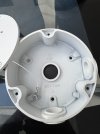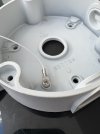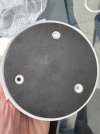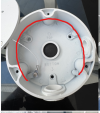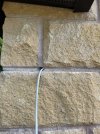Ooof... The split face block sucks.
Options I see, in no specific order:
- Chip/grind down the area for a more consistently flat area to center mount the box over the current wire opening.
- Make the current hole bigger, put in a small piece of EMT to weatherize the opening (leaving a stub) that transitions to liquid-tight. Create a small service loop and connect to the box (from the bottom) mounted on the block to the upper right.
- Make a new hole in the block face to the upper right, center mount over the hole
Concerned the first option does allow for a solid anchoring surface... without a lot of effort
Option two will be less appealing to those favoring (demanding?) a 'clean' look
Of course... option 3 is dependent on what space/access is available behind the block. But it provides a solid almost flat anchoring surface and it looks as though the sealant will easily make up for the not-completely-smooth surface. Plus... you'll only be making holes in one block... not three.
</.02>
